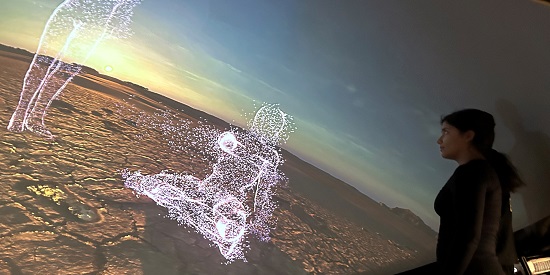The Fire Within: New exhibition explores cultural connection to place
Media release
An immersive exhibition for all ages opens at Deakin University's Waterfront Campus during NAIDOC Week next week promising to transform the way visitors understand Australia’s cultural past and present.
The Fire Within showcases the groundbreaking digital production The Earth Above: A Deep Time View of Australia’s Epic History. The 30-minute planetarium show immerses viewers in Australia's past 140,000 years through both traditional and scientific knowledge.
Inside the planetarium, viewers will be transported to four locations across Australia: Girraween Lagoon on Larrakia and Wulna Country outside Darwin in the NT; Cloggs Cave on Gunaikurnai Country in Victoria's East Gippsland region; Lake Mungo in NSW on the lands of Barkandji/Paakantyi, Ngiyampaa and Mutthi Mutthi peoples; and Jiigurru (Lizard Island) on the Great Barrier Reef, which is sacred to many, including the Dingaal community.
The Earth Above was presented for two days in October last year as part of the 2023 Geelong Design Week and returns to Geelong for a twelve-week run in this specially curated exhibition by Deakin Library.
Alongside The Earth Above, the exhibition will also showcase a new site-specific artwork by Geelong-based artist Lowell Hunter. Lowell, who is also known as The Salty One, is a proud Nyul Nyul Saltwater man from the Kimberleys in Western Australia and grew up on Gunditjmara Country in Warrnambool, now living on Wadawurrung Country, Djilang (Geelong). His art tells stories of family, connection and identity through sand carvings made using foot movements drawn from traditional dance.
This large-scale installation, featuring sand-art and multimedia, is called Embers of Connection: A Journey Through Fire, Sand and Country and was commissioned to coincide with NAIDOC Week and its 2024 theme: Keep the Fire Burning! Blak, Loud & Proud.
Deakin's University Librarian Hero Macdonald said Deakin Library was excited to bring this incredible exhibition to the local community.
'Libraries are all about making knowledge available. The Fire Within offers visitors a chance to experience First Nations knowledge in a way they never have before,' Mx Macdonald said.
'This immersive exhibition will invite our visitors to step into a world where Western archaeological research, traditional knowledges and innovative technologies combine to offer insights into Australia's and Geelong's rich cultural history through deep time.
'We are honoured to partner with Lowell Hunter and the Deakin Motion Lab to produce this ground-breaking work for NAIDOC Week.'
Deakin Library developed The Fire Within exhibition in collaboration with the Australian Research Council Centre of Excellence for Australian Biodiversity and Heritage(CABAH), whose mission is to share what they call "Australia’s Epic Story": a culturally inclusive, globally significant human and environmental history of Australia.
The Earth Above producer, Dr Martin Potter from the Deakin Motion Lab, said Traditional Owners and key community members from each nation have intricately woven their stories into the film, contributing to every aspect from writing and narration to animation.
'This work entangles Indigenous knowledge and CABAH's research, offering a transformative insight into Australia's extensive cultural and environmental past represents a change in thinking in both research methodologies and our perception of Country and place,' Dr Potter said.
'This project profoundly demonstrates that deep time is intrinsically human, highlighting our existence's relevance rather than diminishing it. It underscores our perpetual connection to everything and everyone on Earth, prompting a reflective question: 'What legacy shall we leave behind'?'
The Fire Within is on display at the Alfred Deakin Prime Ministerial Library, entry via Cunningham St, Geelong, and will be open free to the public Monday to Friday, 9am to 5pm, from 9 July until 27 September.

